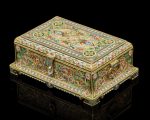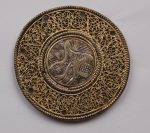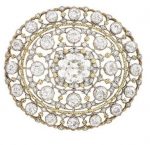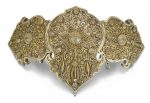Filigree (also less commonly spelled filagree, and formerly written filigrann or filigrene) is a delicate kind of jewellery metalwork, usually of gold and silver, made with tiny beads or twisted threads, or both in combination, soldered together or to the surface of an object of the same metal and arranged in artistic motifs. It often suggests lace and remains popular in Indian and other Asian metalwork. It was popular as well in Italian, French and Portuguese metalwork from 1660 to the late 19th century. It should not be confused with ajoure jewellery work, the ajoure technique consisting of drilling holes in objects made of sheet metal.
A silver-gilt and enamel casket 11th Artel, Moscow, 1908-1917 rectangular with hinged lid, sides with two shaped swing handles, raised on four bracket feet; sides and lid decorated in varicoloured filigree enamel of pastel hues featuring interlaced ornament, four rosettes and intertwined foliage; with swing catch decorated en-suite with the handles, underside of lid engraved with Latin monogram, 84 standard, with scratched inventory number 14.2 x 10 x 5.2cm (5 1/2 x 3 7/8 x 2in).
Sold for £ 8,750 inc. premium at Bonhams in 2018
Belt-fitting; silver, silver gilt, traces of enamel; circular; the central medallion engraved with the figure of a fantastical bird; the outer border of filigree, pierced with holes for attachment. Date 1350-1450 (probably)
Reference: © The Trustees of the British Museum
A JEWEL-MOUNTED AND SILVER FILIGREE MIRROR POSSIBLY PERSIAN, 19TH CENTURY On a velvet ground, with a beveled mirror plate 69 ¾ in. (177.1 cm.) high, 57 in. (144.7 cm.) wide
Sold for USD 27,500 at Christies in 2018
Gold, Silver and Diamond Pendant-Brooch, Buccellati 18 kt., the delicate filigree oval brooch centering one old European-cut diamond approximately 1.75 cts., within an openwork garland frame of 24 collet-set old-mine cut diamonds approximately 2.80 cts., accented by rose-cut diamonds, signed Buccellati, Italy, 9G, approximately 6.6 dwts. With signed pouch.
Sold for $9,375 (includes buyer’s premium) at Doyle New York in 2018
A PAIR OF SILVER GILT ENAMEL FILIGREE DOUBLE GOURD
Each of double gourd form and enamelled on gilt-silver wire ground. Qing Dynasty period.
Sold for $2,900 at California Asian Art Auction Gallery USA in 2019
Book Cover with Byzantine Icon of the Crucifixion,1000 (ivory); before 1085 (setting) Byzantine (ivory); Spanish (setting) Byzantine ivories were highly prized in western Europe, where they survived in church treasuries or were incorporated into deluxe book bindings. The ivory from the panel on the left originally formed the center of a Byzantine three-paneled icon. It may have been one of the many gifts to the Nunnery of Santa Cruz de la Serós, which was founded by Queen Felicia (d. 1085), wife of Sancho V Ramírez (r. 1076–94), king of Aragon and Navarre. The sumptuous cover also contains a sapphire seal, located to the right of Saint John, inscribed in Arabic with four of the ninety-nine “Beautiful Names” of God.
Reference: The Metropolitan Museum of Art
Archaeological finds in ancient Mesopotamia indicate that filigree was incorporated into jewelry since 3,000 BC. Specific to the city of Midyat in Mardin Province in upper Mesopotamia, a form of filigree using silver and gold wires, known as “telkari”, was developed in the 15th Century. To this day, expert craftsmen in this region continue to produce fine pieces of telkari.The Egyptian jewelers employed wire, both to lay down on a background and to plait or otherwise arranged jour. But, with the exception of chains, it cannot be said that filigree work was much practiced by them. Their strength lay rather in their cloisonné work and their molded ornaments. Many examples, however, remain of round plaited gold chains of fine wire, such as those that are still made by the filigree workers of India, and known as trichinopoly chains. From some of these are hung smaller chains of finer wire with minute fishes and other pendants fastened to them. Reference: Wikipedia
A mesh evening bag Made in Europe, 1900-1940. Evening bag, silver mesh / beads, maker unknown, (Europe), 1900-1940 A rectangular chain purse with nine balls hanging from the base of the mesh sack. There is an oval mount with a twist clip fastening on top. The mount is pressed with a metal filigree pattern with a sphinx head on the front with eight turquoise beads decorating the mount. There is a silver metal chain from two rings attached from the mount, finishing in a hinged chatelaine hook, also in a filigree pattern with turquoise beads. There is an oval mirror inside the top of the mount. The mount lies flat when hung.
Reference: Museum of Applied Art and Sciences
Silver chatelaine with four pendants and one extra chain. Silvered colored metal filigree work.
Reference: Museum of Fine Arts Boston
A silver-gilt belt buckle, Ottoman provinces, probably Greece, 18th/19th century composed of two slightly-curved silver plaques fitted together, surface-side gilt and richly decorated in filigree with stylised foliate scrolls and pomegranate-like details, four small hooks for fastening 18.4 by 30.2cm.
Sold for 2,750 GBP at Sothebys in 2019
Silver filigree brooch with floral motif and butterfly circa 1853 (made)
Reference: © Victoria and Albert Museum











